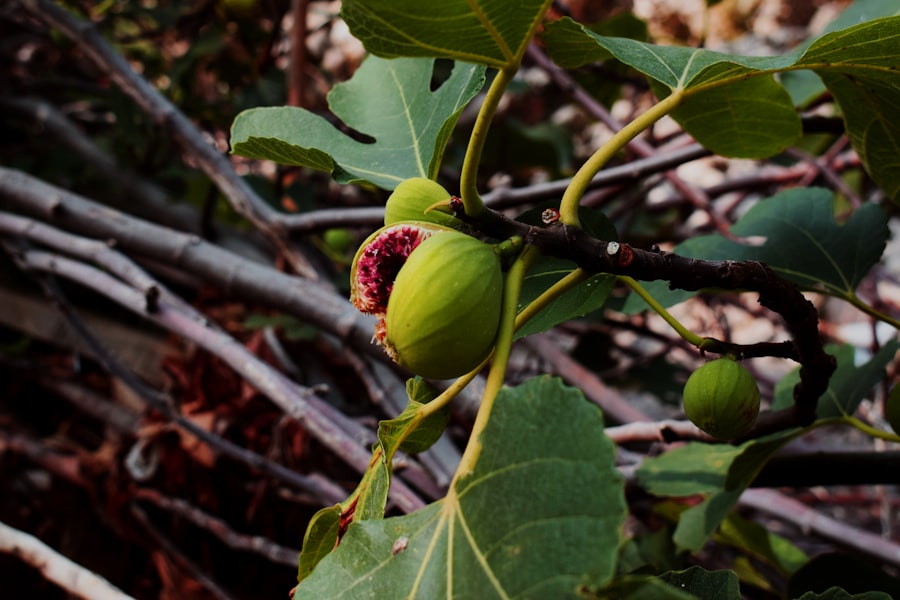Pruning Fig Trees: Timing is Key

Fig tree pruning is an essential practice for maintaining the health and productivity of these fruit-bearing trees. Pruning involves the selective removal of branches and foliage to shape the tree, promote air circulation, and encourage fruit production. By removing dead or diseased branches, pruning helps prevent the spread of diseases and pests. Additionally, pruning allows sunlight to reach the inner parts of the tree, promoting better fruit development.
Key Takeaways
- Timing is crucial when it comes to pruning fig trees.
- Factors such as weather, growth stage, and tree health affect pruning timing.
- Pruning at the right time can lead to increased fruit production and healthier trees.
- Common mistakes to avoid include over-pruning and pruning during the wrong season.
- Proper tools and techniques, as well as aftercare and maintenance, are important for successful fig tree pruning.
Understanding the Importance of Timing
Timing plays a crucial role in fig tree growth and fruit production. Pruning at the right time ensures that the tree is not stressed and can recover quickly from the pruning process. It also minimizes the risk of frost damage to newly pruned branches. Pruning at the wrong time can result in reduced fruit production or even damage to the tree.
Factors Affecting Pruning Timing
Several factors influence the timing of fig tree pruning. Climate and weather conditions are significant considerations. Pruning should be done during the dormant season when the tree is not actively growing. In regions with cold winters, this is typically in late winter or early spring before new growth begins. In warmer climates, pruning can be done in late winter or early fall.
The variety of fig tree also affects pruning timing. Some varieties produce fruit on new growth, while others bear fruit on old wood. Understanding the specific growth habits of your fig tree variety will help determine when to prune for optimal fruit production.
The age of the tree is another factor to consider when deciding on pruning timing. Young trees require less aggressive pruning compared to mature trees. It is important to allow young trees to establish a strong framework before heavy pruning.
Lastly, previous pruning history should be taken into account. If a fig tree has not been pruned for several years, it may require more extensive pruning to remove dead or overcrowded branches.
Identifying the Right Time for Pruning
| Factors | Metrics |
|---|---|
| Tree Health | Number of dead or diseased branches |
| Tree Growth | Height and width of the tree |
| Season | Time of year and weather conditions |
| Tree Species | Growth habits and pruning requirements |
| Pruning Objectives | Reasons for pruning, such as shaping or removing hazards |
To determine the right time for pruning, there are several signs to look for in the tree. During the dormant season, the tree will have shed its leaves, making it easier to assess its overall structure. Look for dead or diseased branches, as well as any branches that are crossing or rubbing against each other. These should be pruned to improve air circulation and prevent disease.
Timing can also be based on climate and weather conditions. In regions with cold winters, pruning should be done before new growth begins in late winter or early spring. In warmer climates, pruning can be done in late winter or early fall.
Fig tree varieties can have different fruiting habits, so timing may vary. Varieties that bear fruit on new growth should be pruned in late winter or early spring before new growth starts. Varieties that bear fruit on old wood should be pruned after fruiting in late summer or early fall.
Benefits of Pruning at the Right Time
Pruning at the right time offers several benefits for fig trees. Firstly, it promotes increased fruit production. By removing dead or overcrowded branches, pruning allows sunlight to reach the inner parts of the tree, improving fruit development and ripening. Pruning also helps maintain a balanced tree structure, ensuring that energy is directed towards fruit production rather than excessive vegetative growth.
Pruning at the right time also improves tree health. By removing dead or diseased branches, pruning prevents the spread of diseases and pests. It also promotes air circulation within the tree, reducing the risk of fungal infections.
Furthermore, pruning at the right time makes maintenance and management of fig trees easier. With a well-pruned tree, it is easier to access and harvest the fruit. Pruning also helps control the size of the tree, making it more manageable for regular maintenance tasks such as watering and fertilizing.
Common Mistakes to Avoid while Pruning Figs

While pruning is essential for fig tree health and fruit production, there are some common mistakes to avoid. Over-pruning is a common mistake that can weaken the tree and reduce fruit production. It is important to strike a balance between removing enough branches to promote air circulation and fruit development, and leaving enough foliage to support the tree’s growth.
Pruning at the wrong time is another mistake to avoid. Pruning during the active growing season can stress the tree and inhibit its ability to recover. Pruning too late in the season can also expose newly pruned branches to frost damage.
Improper pruning technique is another common mistake. It is important to make clean cuts at the right angle to promote healing and prevent disease. Avoid leaving stubs or making jagged cuts that can invite pests and diseases.
Tools and Techniques for Pruning Fig Trees
To properly prune fig trees, it is important to have the right tools and use proper techniques. Pruning tools for fig trees include hand pruners, loppers, and pruning saws. Hand pruners are suitable for small branches up to 1/2 inch in diameter, while loppers can handle branches up to 2 inches in diameter. Pruning saws are necessary for larger branches.
When making cuts, it is important to use proper pruning techniques. Make clean cuts just above a bud or lateral branch, angling the cut away from the bud or branch collar. This promotes healing and prevents disease. Avoid leaving stubs or making flush cuts, as these can inhibit healing and invite pests and diseases.
Safety precautions should also be taken when pruning fig trees. Wear protective gloves and eyewear to prevent injuries from thorns or falling debris. Use a sturdy ladder or platform when pruning higher branches, and be aware of your surroundings to avoid accidents.
Preparing Fig Trees for Pruning
Before pruning fig trees, it is important to prepare the tools and the tree itself. Clean and sterilize pruning tools to prevent the spread of diseases. Use a solution of 1 part bleach to 9 parts water to disinfect the tools. Rinse and dry them thoroughly before use.
Prepare the tree for pruning by removing any debris or dead leaves around the base. This will make it easier to access the branches and ensure a clean pruning process. It is also important to make cuts at the right angle, just above a bud or lateral branch, to promote healing and prevent disease.
Aftercare and Maintenance of Pruned Fig Trees
After pruning, fig trees require proper aftercare and maintenance to ensure optimal growth and fruit production. Water the tree deeply after pruning to help it recover from the stress of pruning. Apply a balanced fertilizer to provide essential nutrients for new growth.
Monitor the tree for pests and diseases, especially in newly pruned branches. Treat any issues promptly to prevent further damage. Regular maintenance tasks such as watering, fertilizing, and monitoring for pests and diseases should be continued throughout the growing season.
Regular maintenance pruning may also be necessary to maintain the shape and health of the tree. Remove any dead or diseased branches as soon as they are noticed, and thin out overcrowded branches to improve air circulation.
Timing Matters in Fig Tree Pruning
In conclusion, timing plays a crucial role in fig tree pruning. Pruning at the right time promotes increased fruit production, improved tree health, and easier maintenance and management. Factors such as climate, fig tree variety, age of the tree, and previous pruning history should be considered when determining the right time for pruning.
By avoiding common mistakes such as over-pruning, pruning at the wrong time, and improper technique, fig tree owners can ensure optimal growth and fruit production. Using the right tools and techniques, preparing the tree for pruning, and providing proper aftercare and maintenance will further contribute to the health and productivity of fig trees. With proper care, fig trees can thrive and provide abundant fruit for years to come.
If you’re wondering when to trim a fig tree, you’ll find some helpful insights in this informative article from Lawn World. Understanding the proper timing and techniques for pruning your fig tree is essential for its health and productivity. Discover expert tips and guidelines on fig tree trimming by visiting Lawn World. Additionally, you can explore their sitemap at https://www.lawnworld.com/sitemap.html to access a wide range of valuable resources related to gardening and lawn care.
FAQs
What is a fig tree?
A fig tree is a fruit-bearing tree that belongs to the mulberry family. It is native to the Middle East and Mediterranean regions.
Why do you need to trim a fig tree?
Trimming a fig tree is necessary to maintain its shape, promote healthy growth, and increase fruit production.
When is the best time to trim a fig tree?
The best time to trim a fig tree is during its dormant season, which is usually in late winter or early spring before new growth appears.
How do you trim a fig tree?
To trim a fig tree, you should remove any dead, diseased, or damaged branches first. Then, you can prune back any overgrown or crossing branches to maintain the tree’s shape and encourage new growth.
What tools do you need to trim a fig tree?
You will need a pair of sharp pruning shears or loppers to trim a fig tree. It is also recommended to wear gloves and eye protection.
Can you trim a fig tree during the growing season?
It is not recommended to trim a fig tree during the growing season as it can cause stress to the tree and reduce fruit production. However, if necessary, you can trim back small branches or suckers during the summer months.



